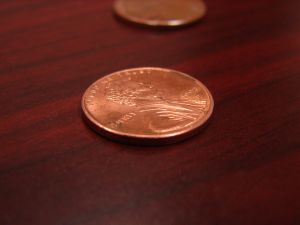25.1 - Uniqueness Property of M.G.F.s
25.1 - Uniqueness Property of M.G.F.sRecall that the moment generating function:
\(M_X(t)=E(e^{tX})\)
uniquely defines the distribution of a random variable. That is, if you can show that the moment generating function of \(\bar{X}\) is the same as some known moment-generating function, then \(\bar{X}\)follows the same distribution. So, one strategy to finding the distribution of a function of random variables is:
- To find the moment-generating function of the function of random variables
- To compare the calculated moment-generating function to known moment-generating functions
- If the calculated moment-generating function is the same as some known moment-generating function of \(X\), then the function of the random variables follows the same probability distribution as \(X\)
Example 25-1

In the previous lesson, we looked at an example that involved tossing a penny three times and letting \(X_1\) denote the number of heads that we get in the three tosses. In the same example, we suggested tossing a second penny two times and letting \(X_2\) denote the number of heads we get in those two tosses. We let:
\(Y=X_1+X_2\)
denote the number of heads in five tosses. What is the probability distribution of \(Y\)?
Solution
We know that:
- \(X_1\) is a binomial random variable with \(n=3\) and \(p=\frac{1}{2}\)
- \(X_2\) is a binomial random variable with \(n=2\) and \(p=\frac{1}{2}\)
Therefore, based on what we know of the moment-generating function of a binomial random variable, the moment-generating function of \(X_1\) is:
\(M_{X_1}(t)=\left(\dfrac{1}{2}+\dfrac{1}{2} e^t\right)^3\)
And, similarly, the moment-generating function of \(X_2\) is:
\(M_{X_2}(t)=\left(\dfrac{1}{2}+\dfrac{1}{2} e^t\right)^2\)
Now, because \(X_1\) and \(X_2\) are independent random variables, the random variable \(Y\) is the sum of independent random variables. Therefore, the moment-generating function of \(Y\) is:
\(M_Y(t)=E(e^{tY})=E(e^{t(X_1+X_2)})=E(e^{tX_1} \cdot e^{tX_2} )=E(e^{tX_1}) \cdot E(e^{tX_2} )\)
The first equality comes from the definition of the moment-generating function of the random variable \(Y\). The second equality comes from the definition of \(Y\). The third equality comes from the properties of exponents. And, the fourth equality comes from the expectation of the product of functions of independent random variables. Now, substituting in the known moment-generating functions of \(X_1\) and \(X_2\), we get:
\(M_Y(t)=\left(\dfrac{1}{2}+\dfrac{1}{2} e^t\right)^3 \cdot \left(\dfrac{1}{2}+\dfrac{1}{2} e^t\right)^2=\left(\dfrac{1}{2}+\dfrac{1}{2} e^t\right)^5\)
That is, \(Y\) has the same moment-generating function as a binomial random variable with \(n=5\) and \(p=\frac{1}{2}\). Therefore, by the uniqueness properties of moment-generating functions, \(Y\) must be a binomial random variable with \(n=5\) and \(p=\frac{1}{2}\). (Of course, we already knew that!)
It seems that we could generalize the way in which we calculated, in the above example, the moment-generating function of \(Y\), the sum of two independent random variables. Indeed, we can! On the next page!